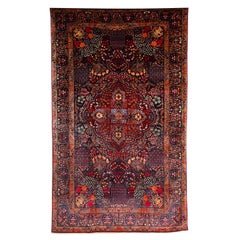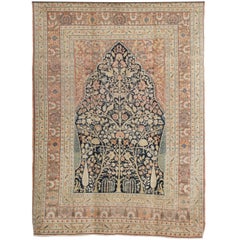Tabriz Antiquities
Tabrīz rugs and carpets are named for their place of origin — the northwestern Iranian city of Tabrīz (or Tabriz). To collectors of antique and vintage Persian carpets and rugs, it is one of history’s best-known hubs for textiles and other handicrafts. Tabriz is among the most populous cities in Iran and home to a rich tradition of hand-knotted rugs. The region’s weavers and their craft flourished under the Safavid dynasty between the 12th and 16th centuries after the Safavids wrested control of the city from the Turks.
Aside from asymmetrical knots, the characteristics of antique Tabriz rugs and carpets include intricate patterns and designs woven from silk and wool. (Antique rugs are primarily woven from the latter.) Like Turkish rugs, Tabriz and other Persian rugs often reflect the region where they were made and typically feature floral and garden motifs with bold maroon, gold and red palettes. The most iconic motif found in Tabriz rugs is a central medallion that radiates outward into other star-shaped pendants and cartouches, with quarter medallions positioned on the corners, while special variations feature curling arabesque floral motifs and hunting scenes. There are rich hues of ivory, copper, terracotta and burgundy with complementing highlights of navy blue and deep green.
While weavers traditionally rely on their fingers to produce the knots in Persian rugs and carpets, local weavers in Tabriz utilize a knife with a buttonhook-like projection to increase their speed. Some of the region’s artisans have set records for weaving faster than one knot per second. These rugs feature an integration of knots that are both Persian and Turkish in origin, and have a double weft made with cotton, wool or silk and cotton warps. This unique process makes these textiles the product of one of the finest and most delicate rug-making traditions in the world.
Tabriz carpets, along with other types of Persian rugs, have experienced a contemporary revival in the past few decades and are a coveted and distinctive piece of craftsmanship in many homes and other interior spaces.
Find a collection of antique and vintage Tabriz rugs and carpets, wall decorations and other furniture on 1stDibs.
19th Century Persian Antique Tabriz Antiquities
Wool
Late 19th Century Persian Antique Tabriz Antiquities
Wool
19th Century Persian Antique Tabriz Antiquities
Wool
19th Century Persian Antique Tabriz Antiquities
Wool
19th Century Persian Antique Tabriz Antiquities
Wool
19th Century Persian Antique Tabriz Antiquities
Wool
20th Century Persian Tabriz Antiquities
Silk, Wool
1970s Vintage Tabriz Antiquities
Wool, Silk
1890s Persian Antique Tabriz Antiquities
Wool, Cotton
Late 19th Century Persian Antique Tabriz Antiquities
Wool
Early 20th Century Persian Tabriz Antiquities
Cotton, Wool
1890s Persian Antique Tabriz Antiquities
Wool, Cotton
1910s Persian Vintage Tabriz Antiquities
Wool, Cotton
Early 20th Century Persian Tabriz Antiquities
Wool
Early 20th Century Persian Tabriz Antiquities
Wool
Late 20th Century Pakistani Tabriz Antiquities
Wool
19th Century Persian Antique Tabriz Antiquities
Wool
1890s Persian Antique Tabriz Antiquities
Wool, Cotton







